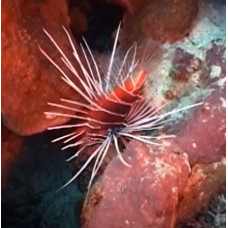Latin name
Pterois radiata
Other names
Tailbar lionfish, radiata lionfish, fireworks fish, radial firefish.
Identification
Have 12-13 venomous spines on the back and several clusters in the pelvic and anal fins. Bare pectoral rays connected by small membranes.
Features of fish fins
Dorsal spines (total): 11-13; Dorsal soft rays (total): 10-12; Anal spines: 3; Anal soft rays: 6-7.
Fish colouring
The large pectoral fins are spread sideways, transparent and without stripes. The other fins are also colorless. The coloration of the head and body is reddish brown with about six vertical dark stripes of different colors on the body, separated by thin white lines. There are two white horizontal lines on the tail stalk that distinguish this fish from other similar Pterois. This is the only species that has spines without any markings.
Distribution
The species is found in tropical waters of the Indian and Pacific Oceans. It is most commonly found in the Red Sea, western areas of the Pacific Ocean, and northern Australia.
Habitat
Marine tropical species. Prefers to live in lagoons and on seaward reefs from reef banks to 30 m.
Size
Grows to 25 centimeters in length. The most common length is 20 centimeters.
Behavior
A rare species found in lagoons and offshore reefs. Prefers rocky reefs and seems to avoid stony corals. It is a coastal fish, sometimes found in intertidal areas. Mainly nocturnal. During the day it hides in crevices, small caves or under canopies.
Food and feeding habits
They are nocturnal hunters and feed mainly on small crabs and shrimp. During the hunt, the fish make a rapid dash. The fan-shaped pectoral fins act as a trap in which the prey is caught.
Reproduction
Spawning is seasonal. Eggs are pelagic, in a mucous membrane. Maximum fecundity is 30,000 eggs. After a few days, helpless larvae emerge. For the first few days they float in the water column, feeding on the smallest plankton. At a length of 1.5-2 cm the fry go to the bottom way of life.
During the mating season, males become dark and aggressive toward other males. Mating occurs at night. The male lies on the bottom near the female, leaning on the pectoral fins. Then he begins to circle around the chosen one, rising on the rising currents and dragging her behind him. In this way they rise and fall several times. The female releases two hollow mucus tubes containing eggs, which the male fertilizes.
Fishing
Not of commercial interest to fishermen. Fish are caught for sale to aquariums.
Relationship with a person
Capable of inflicting a painful bite. Their venom is poisonous and dangerous to humans. They are a spectacular object to keep in the aquarium.
| Classification | |
| Phylum | Chordata |
| Class | Actinopterygii |
| Squad | Scorpaeniformes |
| Family | Scorpaenidae |
| Genus | Pterois |
| Species | P. radiata |
| Features | |
| Conservation status | Least Concern |
| Habitat | Pelagic |
| Life span, years | No information |
| Maximum body weight, kg | No information |
| Sailing speed, m/s | No information |
| Threat to people | Not edible |
| Way of eating | Predator |
Clearfin lionfish
Tags: clearfin lionfish



